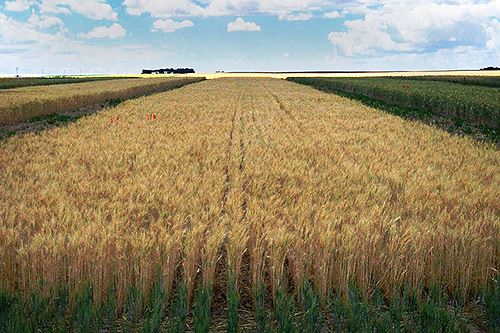As more farmers learn about the benefits of no-till management, they have questions about how, exactly, to make it work on their farms. ARS has answers. A team of scientists has been busy refining a sophisticated model that will predict which crops to plant in which locations for the best outcomes when transitioning to a no-till system.
To do so, the model incorporates a variety of factors — everything from topography to soil composition.
"You have to be very selective, because the crop that is growing is a function of soil type, rainfall, the fertilizer that is applied, therefore where you place the crop will determine where you can get the highest productivity," said Daniel Moriasi, a research hydrologist at the National Laboratory for Agriculture and The Environment in Ames, IA.
Together with colleagues, Moriasi has been adding pieces to the puzzle, building on an existing model (called SWAT, or Soil and Water Assessment Tool) by including more variables, including some specific to the Fort Cobb Reservoir Watershed (FCREW), located in central Oklahoma, where the research is focused. The revised model is known as SWAT-MEA, reflecting the addition of a multi-objective evolutionary algorithm (MEA).

A map of the area researchers studied compares current management practices with recommendations generated by the team’s model to provide optimal outcomes for farmers. (Map by Alan Verser, ARS)
The goal was to create a "proof of concept" illustrating how the model can be applied in decision making — that is, to show that the model can recommend crop placements for optimal yield outcomes. With that proof in hand, the team can move on to conduct more studies to assess the model in different regions under different crop management systems.
"Using a tool like this," Moriasi said, "we can likely identify locations where you minimize erosion, nutrient loss, while at the same time maintaining your crop yields."
The team has published its initial findings, and plans to continue reporting on its work as it adds additional elements to the model. Over time, the group plans to examine more factors — looking, for instance, at economics, in addition to yield information.

Winter wheat is one of the crops that is currently grown in the region covered by the study. Using cutting-edge data about growing conditions, researchers can provide recommendations on the best places to grow winter wheat and other crops when transitioning to a no-till system. Photo by Frank Young, ARS
To make the transition to no-till as seamless as possible, Moriasi and his team only looked at crop replacements that involved another cropping system that is common in the region. That way, farmers are likely to already have the tools and knowledge to grow whichever crop(s) are recommended. In the FCREW area that was the focus of the study, the crops in question were soybeans, winter wheat, grain sorghum, upland cotton, and peanuts.
The results of the initial research have been positive, producing improved water quality while maintaining crop yields. However, the team still foresees additional work to translate the results into a format that will be easy for farmers to access and use. To do that, they may collaborate with colleagues within USDA, as well as seeking outside feedback from potential stakeholders. In doing so, they will be providing farmers with an important input for a win-win outcome, keeping yields robust while also improving soil health at the same time."